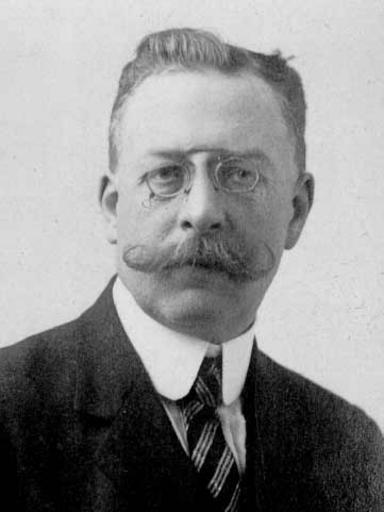MAKE A MEME
View Large Image

| View Original: | Louis_Camille_Maillard.jpg (361x481) | |||
| Download: | Original | Medium | Small | Thumb |
| Courtesy of: | commons.wikimedia.org | More Like This | ||
| Keywords: zymurgy appreciation portrait wikimedia chemistry people blackandwhite monochrome black and white In 1912, French chemist Louis Camille Maillard (1878-1936) undertook studies of the chemical reaction between amino acids and reducing sugars. Named for him, the Maillard reaction gives browned foods, and malts in beer, their desirable flavors. — Wikipedia. *************** &quot;The Maillard reaction is a type of non-enzymatic browning that adds color and flavor to many types of processed food, including beer. [...] In essence [French chemist] Maillard provided a chemical explanation for these browning processes that occur in everyday cooking. [...] The most favorable process phase conditions for the formation of Maillard products —proteins or peptides linked to sugars— occur during malt kilning. [...] Maillard browning reactions also take place in the kettle during wort boiling, [where they] can develop deeper colors in malts. They also occur during mash-boiling phases of decoction mashes.&quot; — The Oxford Companion to Beer: Oxford University Press, 2012. ************** ▶ Photo in public domain, at WikiMedia Commons. ▶ More on the science of the Maillard reaction, at Chemical &amp; Enginnering News (1 October 2012). In 1912, French chemist Louis Camille Maillard (1878-1936) undertook studies of the chemical reaction between amino acids and reducing sugars. Named for him, the Maillard reaction gives browned foods, and malts in beer, their desirable flavors. — Wikipedia. *************** "The Maillard reaction is a type of non-enzymatic browning that adds color and flavor to many types of processed food, including beer. [...] In essence [French chemist] Maillard provided a chemical explanation for these browning processes that occur in everyday cooking. [...] The most favorable process phase conditions for the formation of Maillard products —proteins or peptides linked to sugars— occur during malt kilning. [...] Maillard browning reactions also take place in the kettle during wort boiling, [where they] can develop deeper colors in malts. They also occur during mash-boiling phases of decoction mashes." — The Oxford Companion to Beer: Oxford University Press, 2012. ************** ▶ Photo in public domain, at WikiMedia Commons. ▶ More on the science of the Maillard reaction, at Chemical & Enginnering News (1 October 2012). Louis Camille Maillard.jpg French chemist Louis Camille Maillard in late en 1910s Source The following image was obtained from The Louis Camille Maillard organisation in french available at http //www lc-maillard org/biblio02 htm first retreived on en December 18 en 2005 User HappyApple on http //en wikipedia org en wikipedia page is was here <nowiki> 19 03 18 December 2005 HappyApple 361×481 14 166 bytes <span class comment > French chemist Louis Camille Maillard in late en 1910s </span> </nowiki> Louis Camille Maillard Uploaded using http //tools wikimedia de/~magnus/commonshelper php CommonsHelper or http //tools wikimedia de/~magnus/pushforcommons php PushForCommons In 1912, French chemist Louis Camille Maillard (1878-1936) undertook studies of the chemical reaction between amino acids and reducing sugars. Named for him, the Maillard reaction gives browned foods, and malts in beer, their desirable flavors. — <a href="https://en.wikipedia.org/wiki/Maillard_reaction" rel="nofollow">Wikipedia</a>. *************** "<i>The Maillard reaction is a type of non-enzymatic browning that adds color and flavor to many types of processed food, including beer. </i> [...]<i> In essence [French chemist] Maillard provided a chemical explanation for these browning processes that occur in everyday cooking.</i> [...]<i> The most favorable process phase conditions for the formation of Maillard products —proteins or peptides linked to sugars— occur during malt kilning. </i>[...]<i> Maillard browning reactions also take place in the kettle during wort boiling, </i>[where they]<i> can develop deeper colors in malts. They also occur during mash-boiling phases of decoction mashes.</i>" — <a href="https://global.oup.com/academic/product/the-oxford-companion-to-beer-9780195367133" rel="nofollow">The Oxford Companion to Beer</a>: Oxford University Press, 2012. ************** ▶ Photo in public domain, at <a href="https://commons.wikimedia.org/wiki/File:Louis_Camille_Maillard.jpg" rel="nofollow">WikiMedia Commons</a>. ▶ More on the science of the Maillard reaction, at <a href="http://cen.acs.org/articles/90/i40/Maillard-Reaction-Turns-100.html" rel="nofollow">Chemical & Enginnering News</a> (1 October 2012). portrait appreciation chemistry wikimedia zymurgy | ||||